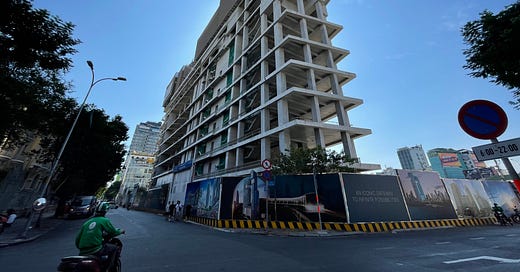Good afternoon! Welcome to the latest subscriber-only edition of the Vietnam Weekly. I’m still tracking the anti-graft campaign but holding off on devoting another issue to it for now. You can upgrade to a paid subscription to receive future editions and access the full archive for US$5/month or US$50/year below.
Today’s newsletter is an expansion of a topic I’ve discussed a lot over the years: Ho Chi Minh City’s struggle to build, specifically public infrastructure and services. If you’ve visited the city over the years, you know there is no struggle to build office towers and apartment complexes (not counting projects like the one in the photo below caught up in real estate scandals). But the public side is another story - one I try to tell below.
As always, if you have any comments or thoughts to add, simply hit ‘reply’ to this email.
On to the news.
Racing Ahead While Standing Still
Ho Chi Minh City is a dynamo. Its economy grew by 9% in 2022, and the city government set a target of 7.5%-8% growth this year.
It contributes nearly a quarter of Vietnam’s annual GDP and in 2020 was named the third-most dynamic city in the world in the JLL City Momentum Index.
My LinkedIn feed is full of posts from investors, VCs, and businesspeople gushing over the energy and potential of the place.
At the same time, HCMC’s public sector is paralyzed to an astonishing degree. This was the case even before the anti-corruption campaign started slowing down the bureaucracy.
At some point in the not-so-distant future, we will learn just how much private capital-led growth is possible when saddled with degraded infrastructure that is woefully inadequate for a city of this size.
Perhaps you think I’m overstating the situation. Let’s start with an incredible data point just in case.



